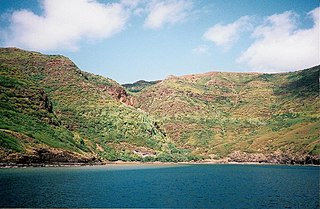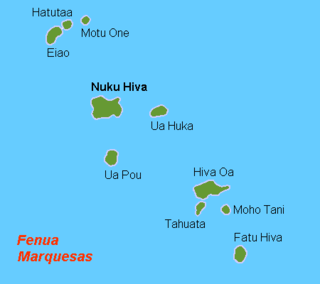
The Marquesas Islands are a group of volcanic islands in French Polynesia, an overseas collectivity of France in the southern Pacific Ocean. Their highest point is the peak of Mount Oave on Ua Pou island, at 1,230 m (4,035 ft) above sea level.

With its 320 square kilometres, Hiva Oa is the second largest island in the Marquesas Islands, in French Polynesia, an overseas territory of France in the Pacific Ocean. Located at 9 45' south latitude and 139 W longitude, it is the largest island of the southern Marquesas group. Around 2,200 people reside on the island. A volcano, Temetiu, is Hiva Oa's highest point with 1,200 metres.

Hatutu is a small island approximately 3 km (2 mi.) northeast of Eiao in the northern Marquesas Islands.

Eiao is the largest of the extreme northwestern Marquesas Islands. The first non-Polynesian encounter with the island was in 1791 by the American sea captain Joseph Ingraham, who named it Knox Island in honour of the U.S. Secretary of War at that time, Henry Knox. Other names given to this island by Western explorers include Masse, Fremantle, and Robert.

Motu Iti is one of the northern Marquesas Islands in French Polynesia. Located west-northwest from Nuku Hiva, Motu Iti is the site of extensive seabird rookeries.

Ua Huka is one of the Marquesas Islands, in French Polynesia, an overseas territory of France in the Pacific Ocean. It is situated in the northern group of the archipelago, approximately 25 mi (40 km) to the east of Nuku Hiva, at 8°54′S139°33′W.

Gallirallus is a genus of rails that live in the Australasian-Pacific region. The genus is characterised by an ability to colonise relatively small and isolated islands and thereafter to evolve flightless forms, many of which became extinct following Polynesian settlement.
Nuku Hiva Airport is an airport on Nuku Hiva in the Marquesas Islands, French Polynesia. The airport is located 19 km (12 mi) northwest of the main village of Taiohae. It is also known as Nuku A Taha. The drive to Taiohae is over dirt roads and takes 90 minutes.

The conquered lorikeet is a species of parrot that became extinct 700–1300 years ago. It lived in islands of Polynesia. David Steadman and Marie Zarriello wrote its species description in 1987.

The red-moustached fruit dove was a species of bird in the family Columbidae. It was endemic to French Polynesia. The last record was of the subspecies P. m. tristrami on Hiva Oa, in 1922. Its extinction has been attributed to predation by the introduced great horned owl, as well as by introduced rats and cats. In 1994, it was listed as an extinct species on the International Union for Conservation of Nature Red List of Endangered Species.
The Marquesan monarch is a species of bird in the family Monarchidae. It is endemic to French Polynesia. Its natural habitats are subtropical or tropical dry forest, subtropical or tropical moist lowland forest, and subtropical or tropical moist montane forest. It is threatened by habitat loss.
This article details the history of the Marquesas. The Marquesas Islands are a group of volcanic islands in French Polynesia, an overseas collectivity of France in the southern Pacific Ocean. The Marquesas Islands comprise one of the five administrative divisions of French Polynesia.

Nuku-Hiva is a commune of French Polynesia, an overseas territory of France in the Pacific Ocean. The commune is in the administrative subdivision of the Marquesas Islands. Its population was 2,951 at the 2017 census.

Nuku Hiva is the largest of the Marquesas Islands in French Polynesia, an overseas country of France in the Pacific Ocean. It was formerly also known as Île Marchand and Madison Island.
The Tahuata rail is an extinct species of flightless bird in the Rallidae, or rail family.
The Ua Huka rail is an extinct species of flightless bird in the Rallidae, or rail family.

Rauvolfia nukuhivensis is a species of plant in the family Apocynaceae. It is endemic to Nuku Hiva in the Marquesas Islands in French Polynesia.

The Marquesan Dog or Marquesas Islands Dog is an extinct breed of dog from the Marquesas Islands. Similar to other strains of Polynesian dogs, it was introduced to the Marquesas by the ancestors of the Polynesian people during their migrations. Serving as a tribal totems and religious symbols, they were sometimes consumed as meat although less frequently than in other parts of the Pacific because of their scarcity. These native dogs are thought to have become extinct before the arrival of Europeans, who did not record their presence on the islands. Petroglyphic representations of dogs and the archaeological remains of dog bones and burials are the only evidence that the breed ever existed. Modern dog population on the island are the descendants of foreign breeds later reintroduced in the 19th century as companions for European settlers.
Libythea collenettei, the Marquesan snout butterfly, is a species of Nymphalid butterfly in the subfamily Libytheinae. The species was first described by Edward Bagnall Poulton and Norman Denbigh Riley in 1923. The specific name honours its original collector, Cyril Leslie Collenette, a member of the 1925 St George Expedition to French Polynesia. It is endemic to French Polynesia, L. collenettei is the only species of butterfly endemic to the Marquesas Islands.












